Click here for the first post in this series.
Most visitors to the Museum of Appalachia are likely to leave with memories of its diverse collection of early Southern Appalachian buildings. John Rice Irwin and his staff have assembled quite a number of them on the Museum grounds.
(Click photos for larger images)
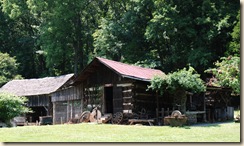 And I do mean “assembled.” Each building has been carefully disassembled at its original site. Every piece numbered and location noted. Then the building was reassembled at its new site on the Museum grounds. Making it look as much as possible like it did before the move.
And I do mean “assembled.” Each building has been carefully disassembled at its original site. Every piece numbered and location noted. Then the building was reassembled at its new site on the Museum grounds. Making it look as much as possible like it did before the move.
Then the real work began! Furnishings selected and placed to give each building that “lived-in” feeling that characterizes the whole complex. Looking through the door the visitor can imagine easily how folks occupying the building lived their lives.
 Before following the proper tour map out the back door of the Main Display Barn, however, let’s double back to Old Tom Cassidy’s house. Visitors often are surprised by how small dwellings were in early Southern Appalachia. The same holds true for Williamsburg, Virginia. Here’s a good example.
Before following the proper tour map out the back door of the Main Display Barn, however, let’s double back to Old Tom Cassidy’s house. Visitors often are surprised by how small dwellings were in early Southern Appalachia. The same holds true for Williamsburg, Virginia. Here’s a good example.
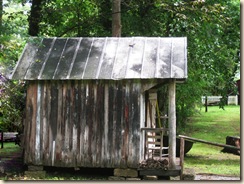 I don’t remember this cabin from the last time I visited the Museum. Though it may well have been here. Just so much to see! According to the information plaque, a friend of John Rice Irwin’s Tom Cassidy, lived here comfortably until his death in 1989.
I don’t remember this cabin from the last time I visited the Museum. Though it may well have been here. Just so much to see! According to the information plaque, a friend of John Rice Irwin’s Tom Cassidy, lived here comfortably until his death in 1989.
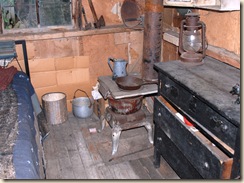 Take a peek inside. It reminds me in some ways of our Little Tin House, the Mobile Studio; our base camp while traveling. Irwin quotes Tom Cassidy’s assessment of his home: “I’ve got that little cot in there, a chair, a stove for heat and cooking, a frying pan, a bean pot, an old dresser, my fiddle (made by his grandfather Fate Cassidy), and my pistol; what more does a man need?” A question worth pondering!
Take a peek inside. It reminds me in some ways of our Little Tin House, the Mobile Studio; our base camp while traveling. Irwin quotes Tom Cassidy’s assessment of his home: “I’ve got that little cot in there, a chair, a stove for heat and cooking, a frying pan, a bean pot, an old dresser, my fiddle (made by his grandfather Fate Cassidy), and my pistol; what more does a man need?” A question worth pondering!
Back through the Main Display Barn and out the back door. Passing reluctantly once again that fascinating gunsmith shop display. We’re on a well-marked path that will take us by most of the display buildings on the site.
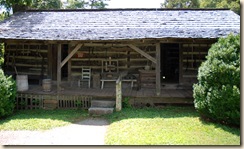 I simply can’t cover all of the buildings the Museum offers for display in this blog entry. Even several entries wouldn’t cover them all. It would be nice to say I’ll cover the “most significant” displays. But that too proves impossible. At least for me. All of the buildings represent rare learning opportunities. Even the smallest. All of them are carefully arranged to provide visitors with information about a particular aspect of Southern Appalachian life.
I simply can’t cover all of the buildings the Museum offers for display in this blog entry. Even several entries wouldn’t cover them all. It would be nice to say I’ll cover the “most significant” displays. But that too proves impossible. At least for me. All of the buildings represent rare learning opportunities. Even the smallest. All of them are carefully arranged to provide visitors with information about a particular aspect of Southern Appalachian life.
So, I’ll swallow pride and select a few building displays to describe here. Interested readers will simply have to arrange a visit to this incredible historical resource. It would be hard not to enjoy the time spent.
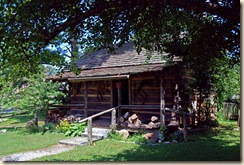 Near the beginning of the Museum’s self-guided “tour” of its many buildings stands the Mark Twain Family Cabin. Mark Twain, or Samuel Clements, himself never lived here. But his parents and siblings did for a while. Not long before he was born. At “’Possum Trot,” Tennessee.
Near the beginning of the Museum’s self-guided “tour” of its many buildings stands the Mark Twain Family Cabin. Mark Twain, or Samuel Clements, himself never lived here. But his parents and siblings did for a while. Not long before he was born. At “’Possum Trot,” Tennessee.
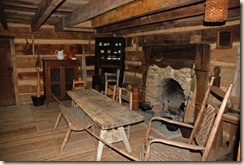 This cabin, as well as any of the displays, demonstrates the attention and skill with which these buildings have been presented. The walls and floors of the building teach the close observer just how cabins of this sort were put together. Nearby shrubbery and other plantings help to give it a sense of place, so to speak.
This cabin, as well as any of the displays, demonstrates the attention and skill with which these buildings have been presented. The walls and floors of the building teach the close observer just how cabins of this sort were put together. Nearby shrubbery and other plantings help to give it a sense of place, so to speak.
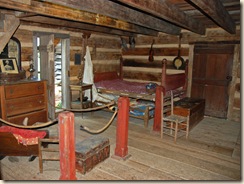 Inside, hundreds of artifacts from the Museum’s collection have been placed just as they might have been used by the cabin’s occupants. This doesn’t just happen!
Inside, hundreds of artifacts from the Museum’s collection have been placed just as they might have been used by the cabin’s occupants. This doesn’t just happen!
Note, for example, the four or five different styles of chairs and benches displayed here. Illustrating the compromise between time and effort required to create them and comfort. Yes, and aesthetic appeal.
Click on the photo above and take a closer look at the tri-cornered display cupboard near the fireplace. With the fine pottery on its shelves. As well as what appears to be a white porcelain pitcher atop another cupboard to its left.
Then imagine the perils of transporting such a fragile item up and down difficult trails to its destination in a cabin at ‘Possum Trot, Tennessee. Can’t you just hear Mother wearying herself with calls to “Take a care with those crates!” And the pained looks of the care-takers as they responded, “Yes, Momma.”
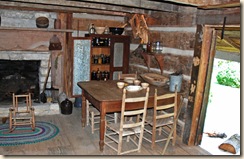 Southern Appalachian people had limited economic resources. But these displays demonstrate that those limitations didn’t dampen their aesthetic senses. They did what was necessary to live, and lived as comfortably as they could. With as many of the “niceties” as they could accumulate. At least, some did.
Southern Appalachian people had limited economic resources. But these displays demonstrate that those limitations didn’t dampen their aesthetic senses. They did what was necessary to live, and lived as comfortably as they could. With as many of the “niceties” as they could accumulate. At least, some did.
On this point, notice too the fiddle and banjo hanging over the four-poster bed. Anyone with a proper musical education can imagine the sounds those instruments in the proper hands would make of an evening. The hours of enjoyment they would provide for musician and listener alike.
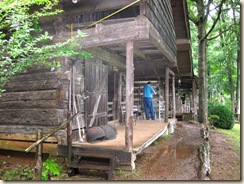 This post is getting far too long. There’s just so much to show and tell. But one final point about music. The Museum of Appalachia makes an effort throughout the exhibits to illustrate the importance of music in Southern Appalachian culture. Rightfully so. Each day I visited the Museum I found a couple of very talented musicians offering up tunes from the porch of the Smoke House. Rain or shine. Literally!
This post is getting far too long. There’s just so much to show and tell. But one final point about music. The Museum of Appalachia makes an effort throughout the exhibits to illustrate the importance of music in Southern Appalachian culture. Rightfully so. Each day I visited the Museum I found a couple of very talented musicians offering up tunes from the porch of the Smoke House. Rain or shine. Literally!
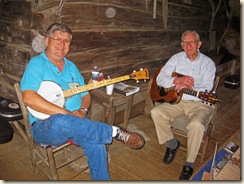 On Monday, in the midst of a solid soaking rain, the performers were Tony C. Thomas and Bill. Bill, the guitarist, didn’t give his last name. But he certainly made some sweet music. I sat for more than a half-hour listening to the magical sounds of Tony and Bill. Using the rain as an excuse not to leave.
On Monday, in the midst of a solid soaking rain, the performers were Tony C. Thomas and Bill. Bill, the guitarist, didn’t give his last name. But he certainly made some sweet music. I sat for more than a half-hour listening to the magical sounds of Tony and Bill. Using the rain as an excuse not to leave.
So, if at all possible, include the Museum of Appalachia in the travel plans for your next vacation.
I can’t imagine anyone, adult or child, not enjoying the time spent.




A lot of this looks similar to the style of the northern Alabama folks of the time. By the time you get over to Arkansas the style has changed somewhat. Make me appreciate window screens and air conditioning.
ReplyDelete